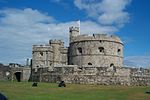SM UB-112
1917 shipsGerman Type UB III submarinesShips built in HamburgU-boats commissioned in 1918World War I submarines of Germany

SM UB-112 was a German Type UB III submarine or U-boat in the German Imperial Navy (German: Kaiserliche Marine) during World War I. She was commissioned into the German Imperial Navy on 16 April 1918 as SM UB-112.UB-112 was surrendered to the Allies at Harwich on 24 November 1918 in accordance with the requirements of the Armistice with Germany; she was used for explosives trials off Falmouth on 20 November and 1 December 1920, after which the boat was dumped on Castle Beach. The wreck was sold for scrap to R. Roskelly & Rodgers on 19 April 1921 for £125, but remains survive in situ.
Excerpt from the Wikipedia article SM UB-112 (License: CC BY-SA 3.0, Authors, Images).SM UB-112
Castle Drive,
Geographical coordinates (GPS) Address Nearby Places Show on map
Geographical coordinates (GPS)
| Latitude | Longitude |
|---|---|
| N 50.14635 ° | E -5.0505444444444 ° |
Address
Castle Drive
TR11 4LP
England, United Kingdom
Open on Google Maps








